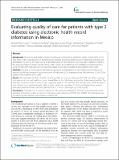| dc.contributor.author | Pérez-Cuevas, Ricardo | |
| dc.contributor.author | Doubova, Svetlana V | |
| dc.contributor.author | Suarez-Ortega, Magdalena | |
| dc.contributor.author | Law, Michael | |
| dc.contributor.author | Pande, Aakanksha H | |
| dc.contributor.author | Escobedo, Jorge | |
| dc.contributor.author | Espinosa-Larrañaga, Francisco | |
| dc.contributor.author | Ross-Degnan, Dennis | |
| dc.contributor.author | Wagner, Anita Katharina | |
| dc.date.accessioned | 2013-04-15T17:07:14Z | |
| dc.date.issued | 2012 | |
| dc.identifier.citation | Pérez-Cuevas, Ricardo, Svetlana V. Doubova, Magdalena Suarez-Ortega, Michael Law, Aakanksha H. Pande, Jorge Escobedo, Francisco Espinosa-Larrañaga, Dennis Ross-Degnan, and Anita K. Wagner. 2012. Evaluating quality of care for patients with type 2 diabetes using electronic health record information in Mexico. BMC Medical Informatics and Decision Making 12:50. | en_US |
| dc.identifier.issn | 1472-6947 | en_US |
| dc.identifier.uri | http://nrs.harvard.edu/urn-3:HUL.InstRepos:10534500 | |
| dc.description.abstract | Background: Several low and middle-income countries are implementing electronic health records (EHR). In the near future, EHRs could become an efficient tool to evaluate healthcare performance if appropriate indicators are developed. The aims of this study are: a) to develop quality of care indicators (QCIs) for type 2 diabetes (T2DM) in the Mexican Institute of Social Security (IMSS) health system; b) to determine the feasibility of constructing QCIs using the IMSS EHR data; and c) to evaluate the quality of care (QC) provided to IMSS patients with T2DM. Methods We used a three-stage mixed methods approach: a) development of QCIs following the RAND-UCLA method; b) EHR data extraction and construction of indicators; c) QC evaluation using EHR data from 25,130 T2DM patients who received care in 2009. Results: We developed 18 QCIs, of which 14 were possible to construct using available EHR data. QCIs comprised both process of care and health outcomes. Several flaws in the EHR design and quality of data were identified. The indicators of process and outcomes of care suggested areas for improvement. For example, only 13.0% of patients were referred to an ophthalmologist; 3.9% received nutritional counseling; 63.2% of overweight/obese patients were prescribed metformin, and only 23% had HbA1c <7% (or plasma glucose ≤130 mg/dl). Conclusions: EHR data can be used to evaluate QC. The results identified both strengths and weaknesses in the electronic information system as well as in the process and outcomes of T2DM care at IMSS. This information can be used to guide targeted interventions to improve QC. | en_US |
| dc.language.iso | en_US | en_US |
| dc.publisher | BioMed Central | en_US |
| dc.relation.isversionof | doi:10.1186/1472-6947-12-50 | en_US |
| dc.relation.hasversion | http://www.ncbi.nlm.nih.gov/pmc/articles/PMC3437217/pdf/ | en_US |
| dash.license | LAA | |
| dc.title | Evaluating Quality of Care for Patients with Type 2 Diabetes Using Electronic Health Record Information in Mexico | en_US |
| dc.type | Journal Article | en_US |
| dc.description.version | Version of Record | en_US |
| dc.relation.journal | BMC Medical Informatics and Decision Making | en_US |
| dash.depositing.author | Ross-Degnan, Dennis | |
| dc.date.available | 2013-04-15T17:07:14Z | |
| dc.identifier.doi | 10.1186/1472-6947-12-50 | * |
| dash.contributor.affiliated | Wagner, Anita | |
| dash.contributor.affiliated | Ross-Degnan, Dennis | |


